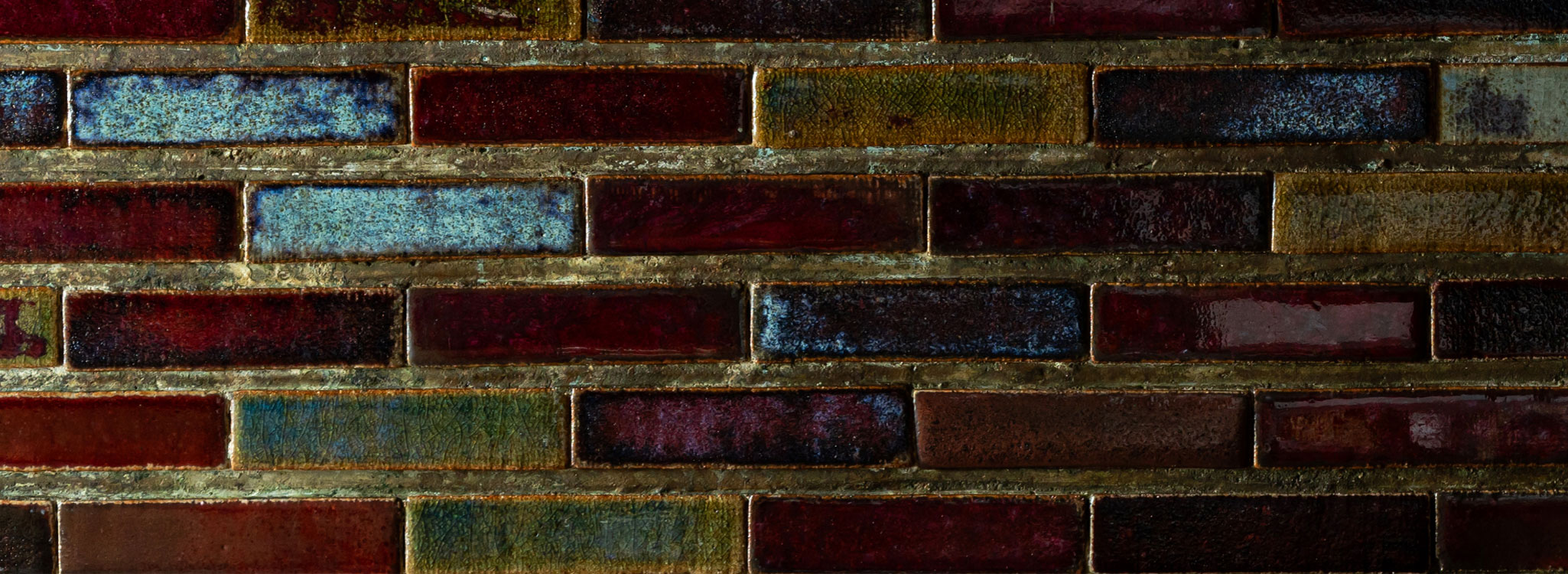Taizan Tiles
The wainscot tiles in the Café Indépendants of the 1928 Building are known as “Taizan-style tiles” (hereafter referred to as Taizan tiles), produced at the Taizan Pottery Factory in Higashikujo, Minami Ward, Kyoto, during the Taisho and early Showa periods.
Founded by Ikeda Taizan, the Taizan Pottery Factory produced a wide variety of ceramic products, including tiles. Influenced by the traditions of Kiyomizu-ware and folk crafts, all the products were handmade, which is one of the factory’s defining characteristics.
Taizan tiles are not typical industrial tiles made with a focus on hygiene; they are art tiles designed to adorn buildings. Due to their beauty, technical precision, and superior quality, they were regarded as the pinnacle of decorative tiles. These tiles were not only sought after throughout Japan but were also ordered from distant places such as Dalian, Seoul, the Philippines, and Thailand.
The Taizan tiles in Café Indépendants are special for three reasons:
1.Custom-made for this location:
Most Taizan tiles were created according to standardized designs and sizes and were used in a variety of locations, from imperial buildings to Western-style residences and traditional Japanese houses. However, the Taizan tiles at Café Indépendants were custom-made for this space. The wall height, width, corners, and columns were all carefully measured before the tiles were created. Since the tiles are ceramic, they warp and shrink during firing, and this was also taken into consideration during production.
2.Unique color of the tiles:
The deep purple color of these tiles is almost impossible to reproduce today. The glaze used is called Shinsa glaze, made from mercury-containing minerals. Although the tiles may appear to use a variety of glazes, including purple, blue, and green, only Shinsa glaze was used. This glaze, originally from China and Korea, was redeveloped to suit Kiyomizu-ware by the Kyoto City Ceramic Laboratory.
The technique for firing this glaze was known only to the Ikeda family. Typically, when using Shinsa glaze, the result would be green or brownish tones, but the Taizan Pottery Factory had the unique ability to achieve a beautiful purple hue by managing the kiln’s temperature. This kiln transformation technique remains a closely guarded secret within the Ikeda family to this day.
Rather than adjusting the oxygen levels inside the kiln, which is a common technique in ceramics, Taizan tiles were fired using only temperature control. They did not rely on thermometers but instead gauged the temperature based on the color and flicker of the flames and the color and quantity of smoke, demonstrating the extraordinary skill of the artisans.
The tiles’ final appearance also depended on where they were placed inside the kiln. The temperature and oxygen levels vary depending on the location within the kiln, leading to natural kiln transformations that gave rise to the unique, non-replicable Taizan tiles. Some tiles were even partially vitrified, creating glass-like areas that sparkle like gemstones—an accidental but alluring effect.
3.The history behind these tiles:
Goichi Takeda, the architect of the 1928 Building, was particularly passionate about the tiles used to decorate the building. His vision was realized by the Taizan Pottery Factory. However, due to the factory’s entirely handmade production process and its many orders at the time, it struggled to meet the project’s deadlines.
The solution was the creation of the “Taihei Tile” brand, established at the suggestion of Goichi Takeda to carry forward Taizan’s techniques in a new form.
The 1928 Building project marked the first occasion for producing Taihei tiles. Although the completed tiles were made by the Taizan Pottery Factory, they also served as prototypes for Taihei tiles. The project was spearheaded by Naokazu Fukuda, a prominent figure in Kyoto’s ceramics community, in collaboration with the Kyoto City Ceramic Laboratory and Taizan Pottery Factory. The tiles were fired at a shared kiln in Higashiyama’s Torincho, operated by Jinmatsu Uno, the only person to become a Living National Treasure for tile-making.
This collaboration among Kyoto’s ceramic community produced the unique tiles used in the 1928 Building’s Café Indépendants. The tiles were created in anticipation of an imperial visit by Emperor Showa to the 1928 Building during his enthronement celebrations. Although the visit ultimately did not take place, the project led to the creation of one-of-a-kind Taizan tiles.
Later, the Taihei tile brand was entrusted to the Tsuji Tokiyoshi Pottery Works in Osaka, where production was fully mechanized, allowing for the mass production of decorative tiles. As a result, Taihei tiles were widely used in buildings associated with Goichi Takeda.
The Taihei Tile brand was named after Naokazu Fukuda’s Taihei Residence, a ceramic production collective. However, the workshop and kiln used by Taihei Residence were not connected to Taizan Pottery Factory or Jinmatsu Uno. It is also important to note that the Taihei Kiln, often confused with Taihei Tiles, is a different entity altogether.
When you visit Café Indépendants in the 1928 Building, I encourage you to touch the Taizan tiles and appreciate their texture and beauty.
(Explanation by Takuya Kashiwabara)
Note: The café’s current name is INDÉPENDANTS.






